Biography
Interests
Gerald Hsu, C.
EclaireMD Foundation, USA
*Correspondence to: Dr. Gerald Hsu, C., EclaireMD Foundation, USA.
Copyright © 2020 Dr. Gerald Hsu, C. This is an open access article distributed under the Creative Commons Attribution License, which permits unrestricted use, distribution, and reproduction in any medium, provided the original work is properly cited.
Introduction
This research note describes how the author applies his personal medical knowledge regarding food nutrition
and chronic diseases control to fight against COVID-19 during his self-quarantine period from 1/19/2020
through 5/14/20.
Method
Figure 1 shows the mortality rate for the leading causes of death in the year 2017 (from US-CDC).
Approximately 2.1 million people died from multiple conditions in the United States. Among them,
the first group, approximately 50% or 1.0 million deaths, is affected by various chronic diseases and their
complications, which were directly or indirectly related to metabolic disorders. The second group, around
29% or 0.6 million, includes various cancers caused by outgrown and mutated cancer cells. The third group,
about 11% or 0.2 million, consists of various infectious diseases resulting from external viral attacks on the
human body cells. The 2020 death percentage due to infectious diseases will be greatly increased by the
COVID-19 outbreaks. Since its death cases have already reached 84,313 on 5/14/2020 and the first official
death count as reported on 3/1/2020. The fourth group, approximately 10%, comprises of accidental and
suicidal death that has nothing to do with physiological diseases, though some suicidal cases are related to
psychological diseases.
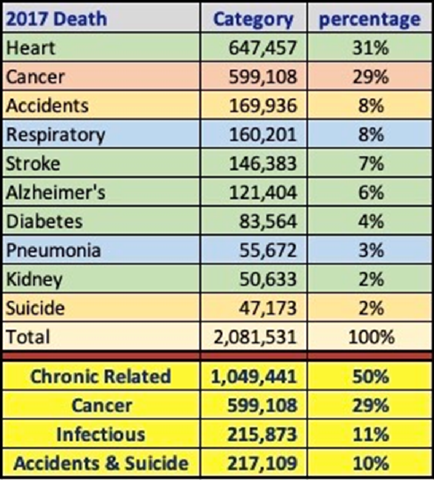
The three groups that resulted in death involved physiological diseases which have a direct connection with one of the following three conditions of the human organ cells: (1) body organ’s functional disorders; (2) outgrown or mutated cells killing normal and healthy cells; or (3) external viral attacks which then kill the organ cells, where COVID-19 belongs in this category.
There are numerous studies proving that by having a strong immune system can prevent the above three leading causes of death, i.e. chronic disease complications, cancers, and viral diseases. Furthermore, many research results have also shown the close connection between immunity and metabolism. Two papers cite that they are linked by proteins of dual function as stated in References [1,2]: the immune system defends against pathogens and maintains tissue homeostasis for the life of the organism. Collectively, these studies have revealed that the metabolic pathways of oxidative metabolism, glycolysis, and glutaminolysis preferentially fuel the cell fate decisions and effector functions of immune cells (Reference [3]). In simple terms, metabolism and immunity are two sides of the same coin.
All human beings are born with both normal and abnormal cells, such as cancer cells. When the immune system gets weaker due to poor metabolic conditions, those bad cells can then grow, mutate, and transport quickly in the body to attack or kill a large portion of the normal cells. In addition, when the external virus enters the body, our immune cells would fight them. However, during the fight, either the immune cells were overtaken by the virus or the immune cells became overactive, it would eventually affect our normal organs to cause death or some degree of permanent organ damage, for example how the COVID-19 virus infects the lungs. This situation is similar to human warfare, where 10,000 enemy soldiers are killed, while we would suffer a casualty of 8,000 of our own soldiers on the battlefields.
In conclusion, having a good metabolism will reinforce our immune system to further reduce the probability of death caused by chronic disease complications, cancers, or infectious diseases by viral attack, such as COVID-19. However, a person’s general health and life longevity are dependent on the following four key conditions with each respective approximate influence’s weighting %:
(1) Genetic conditions, 15%
(2) Environmental conditions, 10%
(3) Medical facility conditions, 10%
(4) Lifestyle conditions, 65%
In order to reduce the probability of death, the author will provide the most fundamental level of health maintenance by explaining them quantitatively and then illustrating how to improve the body’s metabolism such as the personal lifestyle conditions. Again, the best way to protect ourselves is to increase our own lines of defense first. Therefore, we should always go back to strengthening our health foundation by focusing on food nutrition, exercise, and lifestyle management which lead to good metabolic conditions and strong immunity.
In 2014, he utilized concepts of topology from advanced mathematics and finite element technique from advanced engineering to construct a mathematical model of the human metabolism. This system contains 10 categories and nearly 500 elements. Its four output categories contain body weight, glucose, blood pressure, and lipids. Its six input categories contain food, drinking water, exercise, sleep, stress, and daily routines. Finally, by combining all of these 10 categories and 500 elements, he could define a system with a new term known as the “Metabolism Index (MI)” in order to indicate a person’s overall health state at any time instant.
Furthermore, he programmed this metabolism model into an APP software on his iPhone. Therefore, not only could he conduct his daily data input, he will also be able to display his overall MI score and detailed metabolic performance instantly on his mobile phone. Since entering the 500 elements manually would be time consuming, he utilized the artificial intelligence technology to achieve its ease-of-use purpose while maintaining its high data accuracy. Thus far, he has collected about 2 million data related to his own body health. This dataset has more than 1.5 million data related to his daily lifestyle details and the other 0.5 million data related to his various medical conditions, especially chronic diseases.
Here are the metabolic sub-category for his chosen “normal” standards from medical, nutritional, and healthcare viewpoints:
M1 (weight): 170 lbs. (77.3kg)
M2 (glucose): 120 mg/dL (6.7mmol/L)
M3 (blood pressure: SBP/ DBP): 120/80
M4 (lipid: triglyceride/HDL/LDL/total cholesterols): 150/40/130/200
M5 (exercise): 10,000 walking steps
M6 (drinking water): 2,000 cc / day
M7 (sleep): 9 measuring elements with two most prominent elements, sleeping hours and wake up time during sleep
M8 (stress): 19 elements for “psychologically normal” people (only 11 active elements to be used by the author); 15 elements for people who have various “personality disorders” (PD).
M9 (food & meal): 5 elements for food quantity (for weight control), 20 elements for food quality (nutrition)
M10 (daily routine): 15 elements for chronic diseases, 7 elements for cancer’s environmental factors
It should be noted that, due to data normalization, if a person gets a 0.735 score (or 73.5%) of the total MI, it indicates that this person has reached his/her normal standard metabolic target. If MI score is lower than 0.735, this means his/her metabolic condition is better than normal condition (healthy); if the MI score is higher than 0.735, this implies his/her condition is worse than the normal condition (unhealthy).
Results
The author eluded the 2003 SARS threat in China and Taiwan. In early January 2020, when the strange
“Wuhan pneumonia” rumors suddenly appeared on certain Asian news networks, he immediately recognized
the danger associated with this newly found virus. He then started his “self-quarantine” in the United
States on 1/19/2020, much earlier than the majority of Europeans and Americans who became aware of its
potential damage and severity. During the past 116 days, he has been focused on his medical research work
and publishing of his medical papers, while maintaining his personal contacts with outsiders through the use
of the internet only (the ultimate “social-distancing” and almost 100% isolation).
This article will discuss his MI scores and results from his chronic diseases control including food nutrition during this COVID-19 quarantine period of 116 days (1/19/2020 - 5/14/2020).
Food Nutrition
The author has been practicing the following rules for his food nutrition control since 2015 and is paying
closer attention to these rules of nutritional practice during this period, especially those related to immunity
directly. You can check the final results of his medical conditions against his nutritional rules during this
COVID-19 quarantine period:
The following section describes his food nutrition rules during this COVID-19 quarantine period of 116 days (1/19/2020 - 5/14/2020).
(1) In general, 90% of his meals are plant-based diets and 10% are animal-based diets. Among all of those
popular diets in the consumer market, the Mediterranean Diet is his choice of diet.
(2) He maintains a
(3) He
(4) He avoids high-fat animal-based red meat, such as beef, pork, or lamb. He only eats fish and limited
amount of shellfish. He does not like to eat chicken, but chicken (without skin and fat) is a good protein
source food.
(5) He tries to
(6) In summary, he mainly
The following section and Figures 2 through 5, discuss and display the results of his chronic diseases control efforts during this COVID-19 quarantine period of 116 days (1/19/2020 - 5/14/2020).
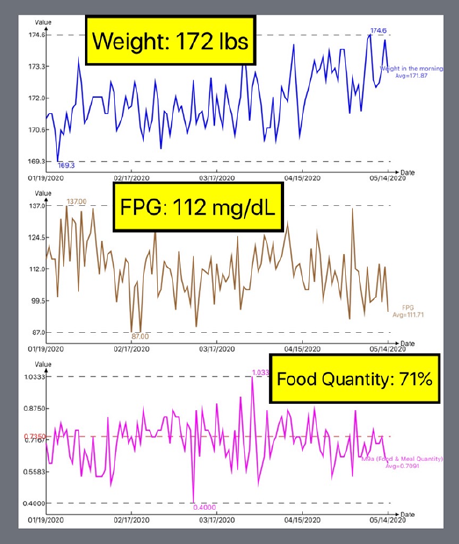
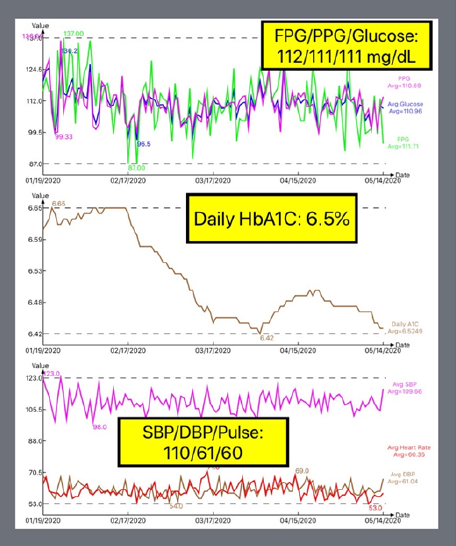
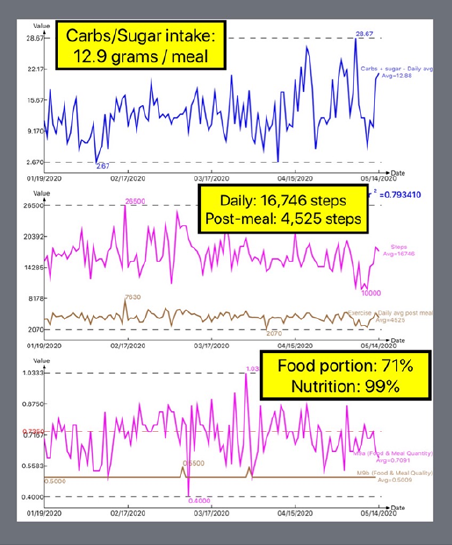
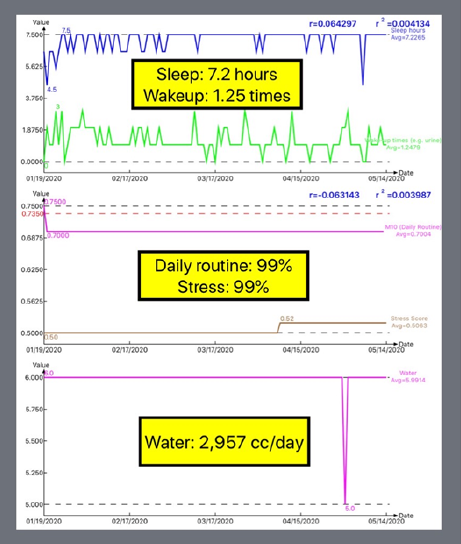
The following data are average results in each metabolic sub-category (MI items) from the COVID-19 quarantine period:
M1 (weight): 171.9 lbs. (BMI 25.4)
M2 (FPG/PPG/Glucose & HbA1C): 112/111/111 mg/dL & 6.5%
M3 (BP: SBP/DBP/pulse): 110/61/60
M4 (lipid: triglyceride/HDL/LDL/total cholesterols): 125/39/96/144
M5 (daily / post-meal walking): 16,746 / 4,525 steps
M6 (drinking water): 2,957 cc/day
M7 (sleep): 83% satisfaction level; with 7.23 hours of sleep time and 1.25 wake up times per night;
M9 (food & meal): food portion at 71% of normal meal’s portion (i.e. weight control) and at
The above scores revealed that his stringent lifestyle management program is successful during the COVID-19 period and as the result, his chronic diseases are continuously under control without taking any medication.
He also believes that his knowledge of food nutrition and his efforts on the metabolic improvements should strengthen his overall immunity directly to protect himself to a degree on the fight against the vicious COVID-19 virus attack [4,5].
Conclusions
The author has demonstrated his detailed food nutritional program and his efforts on managing and improving his overall metabolic conditions during the COVID-19 quarantine period. Through his research and implementation exertions, his immune system would also be strengthened; therefore, having a stronger immunity will also help his body to fight against future attacks from various infectious diseases, including the COVID-19 virus.
Bibliography

Hi!
We're here to answer your questions!
Send us a message via Whatsapp, and we'll reply the moment we're available!